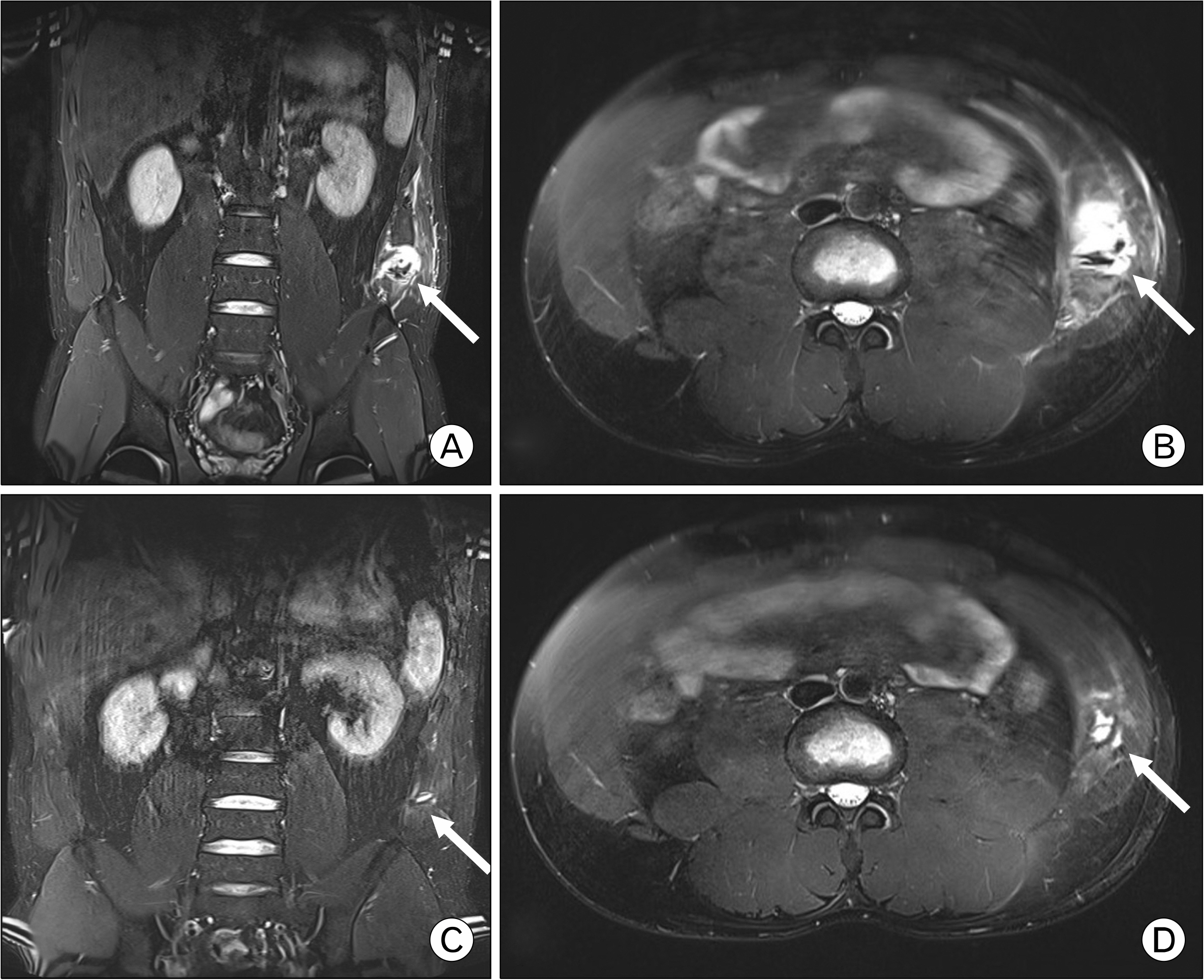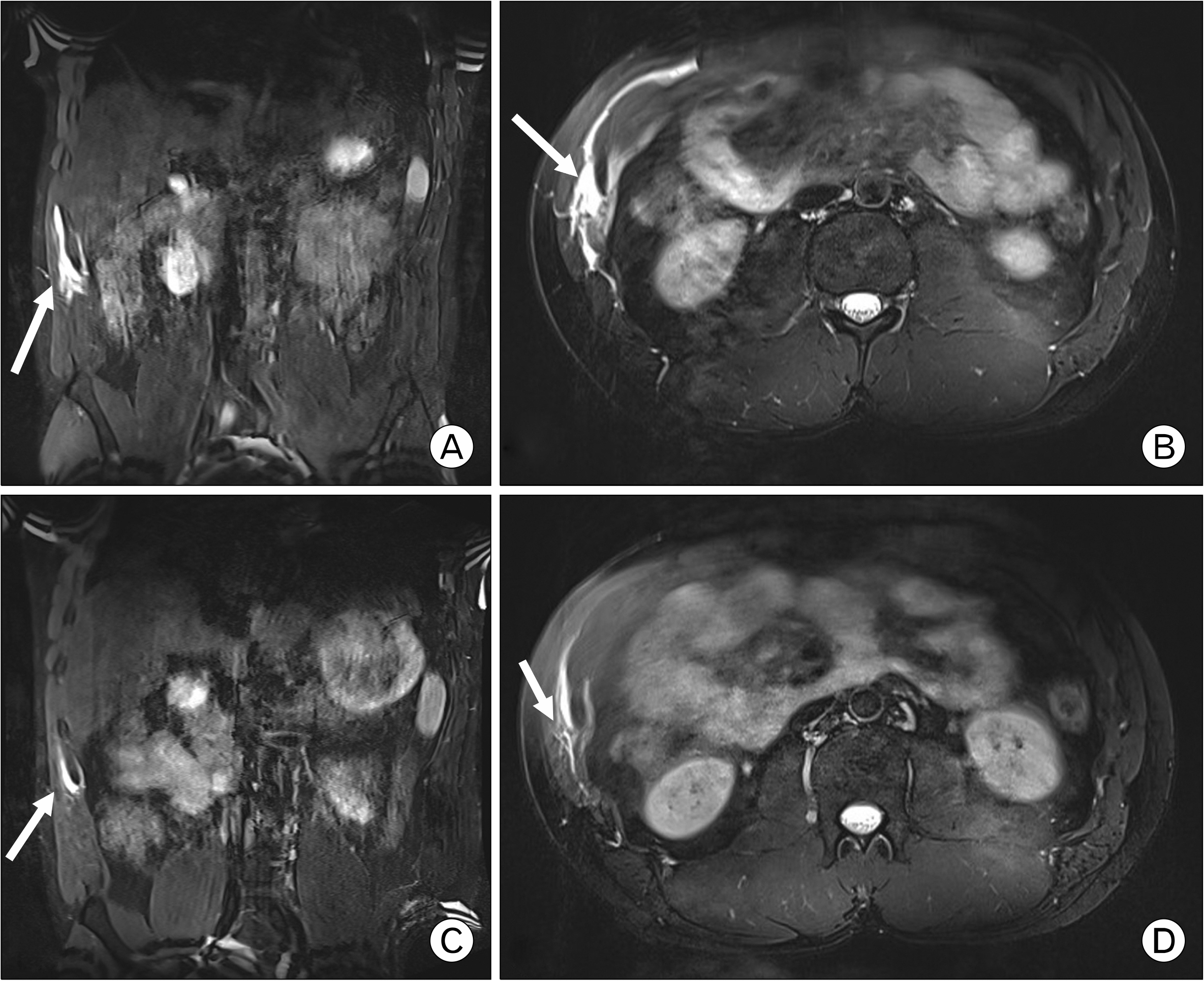Korean J Sports Med.
2023 Dec;41(4):246-249. 10.5763/kjsm.2023.41.4.246.
Nonsimultaneous Bilateral Internal Oblique Muscle Rupture in a Professional Baseball Batter: A Case Report
- Affiliations
-
- 1Department of Orthopaedic Surgery, Good Samsun Hospital, Busan, Korea
- KMID: 2548999
- DOI: http://doi.org/10.5763/kjsm.2023.41.4.246
Abstract
- Abdominal oblique muscle injuries are relatively common in professional baseball players and can result in substantial loss of playing time. It is usually caused by a sudden movement of the torso in sports involving repetitive activity requiring trunk rotation and it tend to occur on the contralateral side of the dominant arm. We report a unique case of sequentially occurred bilateral abdominal internal oblique muscle rupture in a right-handed professional baseball batter over two seasons. Each internal oblique rupture had a different mechanism of the injury, the non-dominant side occurred during bat swing and the dominant side during bent leg sliding. After rest and rehabilitation, each injury was recovered to play in about 1 month.
Figure
Reference
-
1. Camp CL, Conte S, Cohen SB, et al. 2017; Epidemiology and impact of abdominal oblique injuries in major and minor league baseball. Orthop J Sports Med. 5:2325967117694025. DOI: 10.1177/2325967117694025. PMID: 28451598. PMCID: PMC5400149.
Article2. Conte SA, Thompson MM, Marks MA, Dines JS. 2012; Abdominal muscle strains in professional baseball: 1991-2010. Am J Sports Med. 40:650–6. DOI: 10.1177/0363546511433030. PMID: 22268233.3. Connell DA, Jhamb A, James T. 2003; Side strain: a tear of internal oblique musculature. AJR Am J Roentgenol. 181:1511–7. DOI: 10.2214/ajr.181.6.1811511. PMID: 14627566.
Article4. Johnson R. 2006; Abdominal wall injuries: rectus abdominis strains, oblique strains, rectus sheath hematoma. Curr Sports Med Rep. 5:99–103. DOI: 10.1097/01.CSMR.0000306528.74500.bf. PMID: 16529681.5. Andersson EA, Grundström H, Thorstensson A. 2002; Diverging intramuscular activity patterns in back and abdominal muscles during trunk rotation. Spine (Phila Pa 1976). 27:E152–60. DOI: 10.1097/00007632-200203150-00014. PMID: 11884920.
Article6. McGill SM. 1991; Electromyographic activity of the abdominal and low back musculature during the generation of isometric and dynamic axial trunk torque: implications for lumbar mechanics. J Orthop Res. 9:91–103. DOI: 10.1002/jor.1100090112. PMID: 1824571.
Article7. Camp CL, Curriero FC, Pollack KM, et al. 2017; The epidemiology and effect of sliding injuries in major and minor league baseball players. Am J Sports Med. 45:2372–8. DOI: 10.1177/0363546517704835. PMID: 28499094.
Article8. Palmer WE, Kuong SJ, Elmadbouh HM. 1999; MR imaging of myotendinous strain. AJR Am J Roentgenol. 173:703–9. DOI: 10.2214/ajr.173.3.10470908. PMID: 10470908.
Article9. Setayesh K, Villarreal A, Gottschalk A, Tokish JM, Choate WS. 2018; Treatment of muscle injuries with platelet-rich plasma: a review of the literature. Curr Rev Musculoskelet Med. 11:635–42. DOI: 10.1007/s12178-018-9526-8. PMID: 30343400. PMCID: PMC6220013.
Article10. Stevens KJ, Crain JM, Akizuki KH, Beaulieu CF. 2010; Imaging and ultrasound-guided steroid injection of internal oblique muscle strains in baseball pitchers. Am J Sports Med. 38:581–5. DOI: 10.1177/0363546509350105. PMID: 20051499.
Article
- Full Text Links
- Actions
-
Cited
- CITED
-
- Close
- Share
- Similar articles
-
- Secondary Superior Oblique Overaction after Inferior Oblique Muscle Myectomy in a Patient Misdiagnosed with Inferior Oblique Muscle Overaction
- Asymmetric Bilateral Inferior Oblique Transposition of a Bilateral Inferior Oblique Overaction Associated with Dissociated Vertical Deviation
- Traumatic Rupture of the Superior Oblique Muscle Tendon
- Sonoelastography on Supraspinatus Muscle-Tendon and Long Head of Biceps Tendon in Korean Professional Baseball Pitchers
- Adherence Syndrome After Weakening Procedure of Inferior Oblique Muscle



